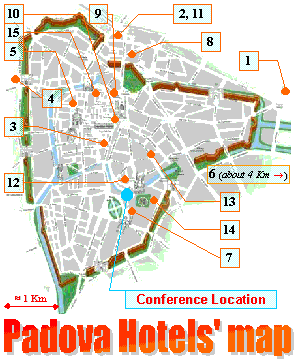
| CHEP INFORMATION |
|
|
|
|
|
|
|
|
|
|
|
|
|
|
| GRID INFORMATION |
| • Grid WShop & Tutorial |
| • Grid Program |
| USEFUL LINKS |
| • Visiting Padova |
| • INFN Padova |
| • University of Padova |
| • CHEP: '94 '95 '97 '98 |
Last update: Nov 3, 2000
Conference Location
The Conference will be held at Teatro Antonianum located nearby "Prato della Valle" square, one of the biggest in Europe.

|
Teatro Antonianum
Via Briosco 7
35100 Padova (ITALIA)
Open a new window with the Street map of Padova (306K jpeg) |
Situated twelve metres above sea level in the lower Venetian plain between the Brenta and the Bacchiglione rivers, about twenty kilometres from the lagoon of Venice, Padova was, according to legend, founded by Antenore, mythical Trojan prince; an important Roman municipality in 452, it was destroyed by Attila. After the period of the free cities (comuni) (11th century), it was the property of Ezzelino da Romano (1237), followed by the Scaligeris and the Carraras, who dominated it until 1405, the year in which it became part of the Republic of Venice; it then shared Venetian vicissitudes until 1797. After the Napoleonic and Lombard-Venetian periods, it became part of the kingdom of Italy in 1866.
Surrounded by the 16th century town wall with its beautiful gates, one of the longest in Italy, Padova has a great artistic and cultural tradition and possesses famous monuments such as Basilica di Sant'Antonio (13th-14th century), Romanesque-Gothic with Venetian and Byzantine elements: in the interior, sculptures by Donatello and Sansovino, paintings by Titian; Palazzo della Ragione (13th-15th century), Cappella degli Scrovegni (early 14th century chapel with frescoes by Giotto), Chiesa degli Eremitani (13th century church with frescoes by Mantegna), Chiesa di Santa Sofia (9th century church), Chiesa di Santa Giustina (16th century church, paintings by Veronese), Duomo (rebuilt in the 16th century) with Battistero (13th century Romanesque baptistry), equestrian statue of Gattamelata, a masterpiece by Donatello.
The Università degli Studi di Padova is the second oldest University in Italy and one of the most ancient in Europe. Juridical, theological, philosophical and medical studies were fostered in the mediaeval town before the ground was prepared for the official birth of a permanent University, which took place on September 29, 1222. From 15th to 18th century, Gymnasium di Padova had a period of great splendour, in which it gave a great contribution to the birth of scientific revolution. In 1545 there was the foundation of the first public Botanical Garden; in 1594/5 the introduction of autopsy as a way to enhance medical knowledge with the construction of the first anatomy theatre; Galileo Galilei had been teaching in this university for 18 years (from 1592 to 1610). The first graduated woman in the world, achieved her degree at the University of Padova (Elena Lucrezia Cornaro Pisapia, degree in philosophy - 1678).